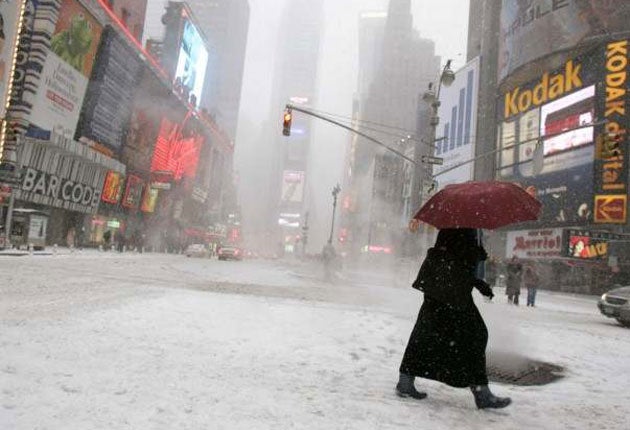Why the Big Apple blows hot and cold
Whatever the weather

Your support helps us to tell the story
From reproductive rights to climate change to Big Tech, The Independent is on the ground when the story is developing. Whether it's investigating the financials of Elon Musk's pro-Trump PAC or producing our latest documentary, 'The A Word', which shines a light on the American women fighting for reproductive rights, we know how important it is to parse out the facts from the messaging.
At such a critical moment in US history, we need reporters on the ground. Your donation allows us to keep sending journalists to speak to both sides of the story.
The Independent is trusted by Americans across the entire political spectrum. And unlike many other quality news outlets, we choose not to lock Americans out of our reporting and analysis with paywalls. We believe quality journalism should be available to everyone, paid for by those who can afford it.
Your support makes all the difference.Like London, New York experiences four distinct seasons. The difference is that New York is influenced by the continental climate, meaning that winters and summers tend to be much more extreme than in the UK. Winters are cold, with biting winds and occasional snow storms.
The city was severely affected by a winter storm in February this year. Even meteorologists, usually quite measured by nature, named it the "monster" storm, so it must have been bad. Nearly 2ft of snow fell in New York, which combined with 45mph gusts of wind, meant it felt pretty raw.
Storms like this don't happen every winter, but when they do it can bring even Manhattan to a standstill. Temperatures regularly fall below freezing and it is quite common for rain to freeze on contact, a phenomenon known as freezing rain, leading to icy roads and pavements.
Summers in New York City can be hot and humid. Daytime temperatures regularly exceed 30C and combined with the high humidity, it can lead to the city feeling very uncomfortable. The night-time conditions can also be very oppressive due to the urban heat island effect – where the city's mass of buildings and concrete acts like a giant storage heater, releasing the daytime heat at night.
New York will often experience high levels of ozone during the height of summer. We're all familiar with the ozone layer in the stratosphere but ozone also exists at ground level. It's created by the sunlight's reaction with pollution from cars and industry. Increased ozone levels can lead to respiratory problems, especially during the afternoon and early evening when levels can be at their highest. The Environmental Protection Agency issues air quality forecasts during the summer and offers advice on how to cope when levels are high.
Spring and autumn are changeable and sometimes a little unpredictable, as the weather depends on the wind direction. One day can be cool and dry, the next wet and mild – a bit like the British weather. However, the annual rainfall (just over 4ft) in New York is quite high compared to most places in the UK. Like Britain, the city is affected by weather systems that bring cloud and rain at pretty much anytime of the year.
Dr Liz Bentley is founder of theWeather Club, formed by the Royal Meteorological Society to promote an appreciation and understanding of the weather. Visit theweatherclub.org.uk for more information.
Join our commenting forum
Join thought-provoking conversations, follow other Independent readers and see their replies
Comments